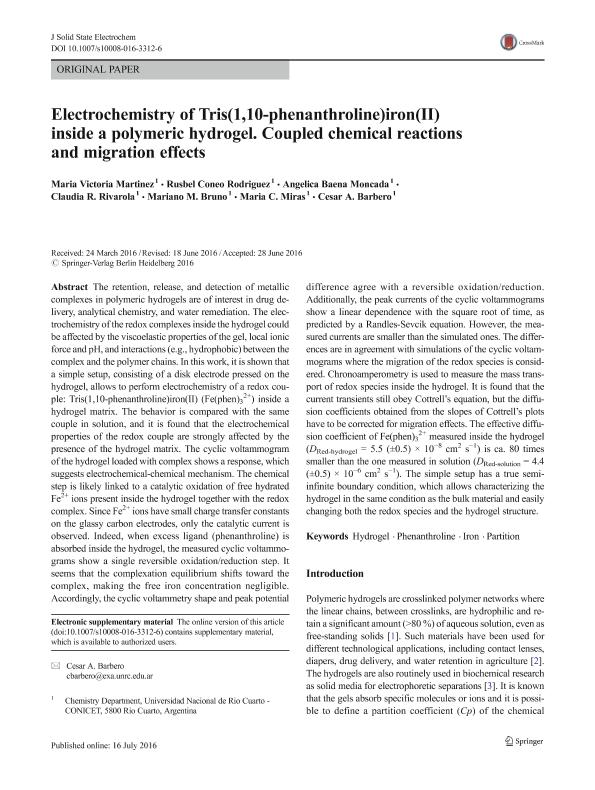Artículo
Electrochemistry of Tris(1,10-phenanthroline)iron(II) inside a polymeric hydrogel. Coupled chemical reactions and migration effects
Martinez, María Victoria ; Coneo Rodriguez, Rusbel
; Coneo Rodriguez, Rusbel ; Baena Moncada, Angelica Maria
; Baena Moncada, Angelica Maria ; Rivarola, Claudia Rosana
; Rivarola, Claudia Rosana ; Bruno, Mariano Martín
; Bruno, Mariano Martín ; Miras, Maria Cristina; Barbero, César Alfredo
; Miras, Maria Cristina; Barbero, César Alfredo
 ; Coneo Rodriguez, Rusbel
; Coneo Rodriguez, Rusbel ; Baena Moncada, Angelica Maria
; Baena Moncada, Angelica Maria ; Rivarola, Claudia Rosana
; Rivarola, Claudia Rosana ; Bruno, Mariano Martín
; Bruno, Mariano Martín ; Miras, Maria Cristina; Barbero, César Alfredo
; Miras, Maria Cristina; Barbero, César Alfredo
Fecha de publicación:
07/2016
Editorial:
Springer
Revista:
Journal of Solid State Electrochemistry (print)
ISSN:
1432-8488
Idioma:
Inglés
Tipo de recurso:
Artículo publicado
Clasificación temática:
Resumen
The retention, release, and detection of metallic complexes in polymeric hydrogels are of interest in drug delivery, analytical chemistry, and water remediation. The electrochemistry of the redox complexes inside the hydrogel could be affected by the viscoelastic properties of the gel, local ionic force and pH, and interactions (e.g., hydrophobic) between the complex and the polymer chains. In this work, it is shown that a simple setup, consisting of a disk electrode pressed on the hydrogel, allows to perform electrochemistry of a redox couple: Tris(1,10-phenanthroline)iron(II) (Fe(phen)3 2+) inside a hydrogel matrix. The behavior is compared with the same couple in solution, and it is found that the electrochemical properties of the redox couple are strongly affected by the presence of the hydrogel matrix. The cyclic voltammogram of the hydrogel loaded with complex shows a response, which suggests electrochemical-chemical mechanism. The chemical step is likely linked to a catalytic oxidation of free hydrated Fe2+ ions present inside the hydrogel together with the redox complex. Since Fe2+ ions have small charge transfer constants on the glassy carbon electrodes, only the catalytic current is observed. Indeed, when excess ligand (phenanthroline) is absorbed inside the hydrogel, the measured cyclic voltammograms show a single reversible oxidation/reduction step. It seems that the complexation equilibrium shifts toward the complex, making the free iron concentration negligible. Accordingly, the cyclic voltammetry shape and peak potential difference agree with a reversible oxidation/reduction. Additionally, the peak currents of the cyclic voltammograms show a linear dependence with the square root of time, as predicted by a Randles-Sevcik equation. However, the measured currents are smaller than the simulated ones. The differences are in agreement with simulations of the cyclic voltammograms where the migration of the redox species is considered. Chronoamperometry is used to measure the mass transport of redox species inside the hydrogel. It is found that the current transients still obey Cottrell?s equation, but the diffusion coefficients obtained from the slopes of Cottrell?s plots have to be corrected for migration effects. The effective diffusion coefficient of Fe(phen)3 2+ measured inside the hydrogel (DRed-hydrogel = 5.5 (±0.5) × 10−8 cm2 s−1) is ca. 80 times smaller than the one measured in solution (DRed-solution = 4.4 (±0.5) × 10−6 cm2 s−1). The simple setup has a true semi-infinite boundary condition, which allows characterizing the hydrogel in the same condition as the bulk material and easily changing both the redox species and the hydrogel structure.
Palabras clave:
HYDROGEL
,
IRON
,
PARTITION
,
PHENANTHROLINE
Archivos asociados
Licencia
Identificadores
Colecciones
Articulos(CCT - CORDOBA)
Articulos de CTRO.CIENTIFICO TECNOL.CONICET - CORDOBA
Articulos de CTRO.CIENTIFICO TECNOL.CONICET - CORDOBA
Articulos(SEDE CENTRAL)
Articulos de SEDE CENTRAL
Articulos de SEDE CENTRAL
Citación
Martinez, María Victoria; Coneo Rodriguez, Rusbel; Baena Moncada, Angelica Maria; Rivarola, Claudia Rosana; Bruno, Mariano Martín; et al.; Electrochemistry of Tris(1,10-phenanthroline)iron(II) inside a polymeric hydrogel. Coupled chemical reactions and migration effects; Springer; Journal of Solid State Electrochemistry (print); 20; 7-2016; 2951-2960
Compartir
Altmétricas



